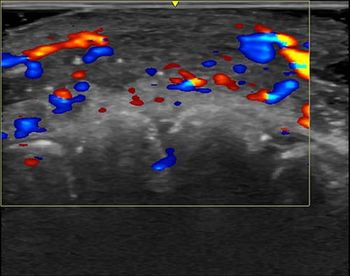
Chest CT Proven Effective at COVID-19 Diagnosis
A study of more than 10,000 images shows the scans achieve high diagnostic accuracy.
Chest CT lived up to the diagnostic hope and expectation during the COVID-19 pandemic, new research has found.
Despite the debate over whether CT was a reliable way to detect and diagnose the virus, a new study published Tuesday in
“In this retrospective cohort study of 10,735 subjects suspected of COVID-19 pneumonia, the overall CT diagnostic accuracy was 80 percent, considering RT-PCR as a reference standard, and increased to 86.3 percent after five days of symptoms,” said the team led by Marie-Pierre Revel, M.D., Ph.D., from the University of Paris. “CT interpretation performance was not influenced by reader experience and enabled a correct diagnosis of COVID-19 pneumonia.”
Whether CT should have been used for COVID-19 detection and diagnosis was a subject of hot debate throughout 2020 with the American College of Radiology pointing to the RT-PCR test as the only specific method of diagnosis. Many organizations in Europe and Asia, however, lauded the scan, relying heavily on it during the height of the pandemic.
To get a better idea of how chest CT actually performed during the outbreak, Revel’s team culled data from the Study of ThOracic computed tomography In COVID-19 (STOIC) project between March 1, 2020, and April 30, 2020. Study participants came from 20 hospital emergency departments throughout France, and they all underwent both chest CT and RT-PCR. Twenty readers of varying experience reviewed their scans and test results, as well as their demographic data, clinical symptoms, and outcomes.
Based on their analysis, Revel’s team determined that chest CT achieved 80.2 percent sensitivity and 79.7 percent specificity for identifying COVID-19. It was also effective in predicting whether a patient would be intubated, as well as the risk of death at the one-month follow-up appointment – both of which were determined by the extent of pneumonia on the chest CT.
When the team evaluated reader interpretation, they found perfect intra-observer agreement for 16 of 20 readers (kappa, 1.00) and near-perfect agreement for the remaining four (kappa, 0.82-0.92).
Despite any of the study’s limitations, said Geoffrey Rubin, M.D., professor and chair of medical imaging at the University of Arizona, this study is a “landmark” publication, and its bearing on future research will be significant.
“It provides a valuable historical record regarding the use of thoracic CT at a highly volatile moment during the early days of the pandemic,” he said in an accompanying
For more coverage based on industry expert insights and research, subscribe to the Diagnostic Imaging e-Newsletter
Newsletter
Stay at the forefront of radiology with the Diagnostic Imaging newsletter, delivering the latest news, clinical insights, and imaging advancements for today’s radiologists.




























